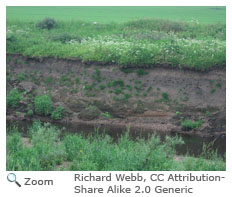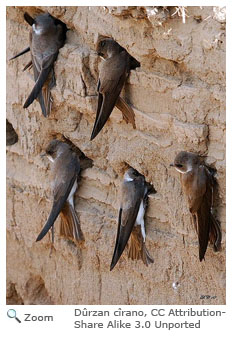Description
 A small, slender songbird, the bank swallow is white underneath and brown on top with a dark band across its chest. With its long wings, it can be seen swooping in the air above waterways. The Bank Swallow lives in colonies along the banks of streams, rivers and coastal areas. A small, slender songbird, the bank swallow is white underneath and brown on top with a dark band across its chest. With its long wings, it can be seen swooping in the air above waterways. The Bank Swallow lives in colonies along the banks of streams, rivers and coastal areas.
Range
The bank swallow breeds throughout much of Alaska and Canada and south into the United States. It breeds along the Rio Grande River in Texas and into Northern Mexico. In the winter, the bank swallow migrates throughout South America. Some colonies spend the winter along the Western coastal slopes of Mexico.
Habitat
 The bank swallow lives in low areas along rivers, streams, ocean coasts and reservoirs. It needs vertical banks and cliffs to form their colonies of nests. Although the bank swallow used to be found mostly around natural banks and waterways, many are now found in human-made sites such as sand and gravel quarries. The bank swallow lives in low areas along rivers, streams, ocean coasts and reservoirs. It needs vertical banks and cliffs to form their colonies of nests. Although the bank swallow used to be found mostly around natural banks and waterways, many are now found in human-made sites such as sand and gravel quarries. |
|
Diet
 A carnivore, the bank swallow eats flying or jumping insects such as bees, wasps, ants, butterflies and moths. They catch food while flying, usually 50 ft above the water or ground. On occasion, the bank swallow will take an insect from the ground or the surface of the water. A carnivore, the bank swallow eats flying or jumping insects such as bees, wasps, ants, butterflies and moths. They catch food while flying, usually 50 ft above the water or ground. On occasion, the bank swallow will take an insect from the ground or the surface of the water.
Life Cycle
 The bank swallow builds an impressive nest. The male uses its bill, feet and wings to dig a burrow which leads to the nest chamber. The burrow can be as long as 25 inches into the side of the bank! By placing the nest so far inside the bank, temperatures remain more constant than the outside air temperature. The bank swallow builds an impressive nest. The male uses its bill, feet and wings to dig a burrow which leads to the nest chamber. The burrow can be as long as 25 inches into the side of the bank! By placing the nest so far inside the bank, temperatures remain more constant than the outside air temperature.
The female builds the actual nest herself, using straw, grass and leaves to form the nest mat. She lays 2-6 white eggs, which she incubates for 13-16 days. Upon hatching, the chicks stay in the nest for another 18-24 days before flying.
Behavior
 The bank swallow nests in large colonies. There can be as few as 10 nests in a colony or as many as 2,000! The bank swallow nests in large colonies. There can be as few as 10 nests in a colony or as many as 2,000! |





